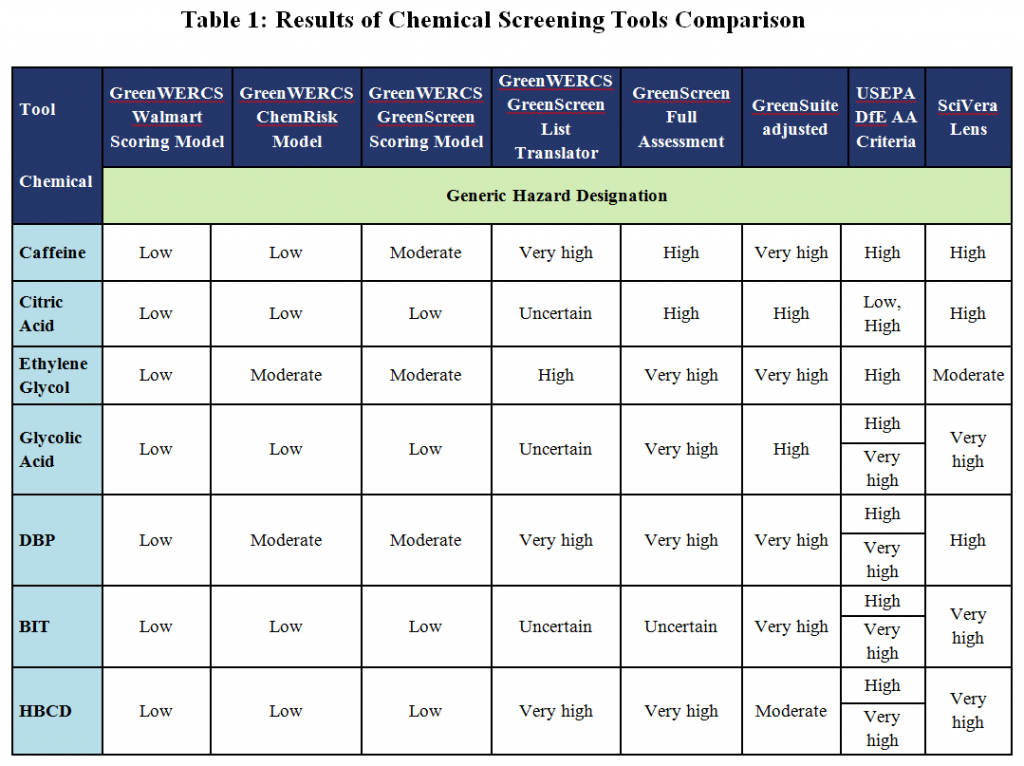Retailers and product manufacturers are increasingly using a variety of tools, lists and other approaches to determine whether specific chemical ingredients in consumer products may be a concern, or to certify what some call “greener” chemical ingredients.
But what sort of information do these various tools provide? To address this question, a group of researchers undertook a comparative analysis of leading chemical assessment tools. They found that when evaluating the same chemical, individual tools come to different conclusions about the hazard categorization of each chemical (see Table 1 for a list of tools and chemicals evaluated).
The researchers used the tools to analyze seven chemicals, including two natural compounds – caffeine and citric acid; a degradation metabolite – glycolic acid; and four synthetic chemicals: ethylene glycol, dibutyl phthalate, benziothiazolinone (BIT), which is also an antimicrobial, and 1,2,4,6,9,10-hexabromocyclododecane (HBCD), which is also a chemical designated as persistent and bioaccumulative by the European Union.
The results show a wide variety of hazard categorizations for the same chemical – ranging from little or no hazard/toxicity to very high hazard/toxicity. For example, caffeine was ranked by two of the tools as a “low” hazard, as a “moderate hazard by one tool, as a “high” hazard by three tools, and as a “very high” hazard by two of the tools.
According to the researchers, different results for the same chemicals were due to variations in: 1) the endpoints each tool considered for evaluation; 2) how each tool weighed the relevance of specific endpoints; 3) the sources of information the tools developer used to gather information; and 4) how each tool treated gaps in available data.
Thus, the study found, the outcome of a hazard tool assessment is highly dependent on the tool selected for the screening.
What’s the difference between “hazard” and “exposure”?
The tools analyzed in the study focus on a chemical’s innate “hazard,” meaning they consider whether the inherent properties of a chemical substance could cause harm to humans or the environment, under any circumstance.
But, the inherent hazard of a chemical ingredient is only one aspect to consider when making informed decisions. Hazard-based screening procedures do not consider how a chemical is actually used in a product, how much of the chemical substance exists in those uses, and whether and to what degree there is human or environmental exposure to the chemical substance through such uses. These properties of use, dose and exposure are a key component of regulatory chemical safety assessments conducted by government agencies around the world.
The results affirm what ACC and regulators have known for decades: to judge a product’s safety, a chemical hazard analysis needs to be put into the context of how and who uses a product.
The study authors conclude that there is a need for enhanced transparency and understanding of what each tool was designed to measure, as well as the appropriate conditions for each tool’s use, and suggest possible enhancements to the tools to increase their utility.
ACC is in the process of conducting a follow-up demonstration study that evaluates chemical ingredients in the context of the whole products and its intended use. A paper presenting the results of this subsequent analysis is under development.






